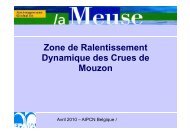PIANC E-Magazine - PIANC AIPCN welcome
PIANC E-Magazine - PIANC AIPCN welcome
PIANC E-Magazine - PIANC AIPCN welcome
Create successful ePaper yourself
Turn your PDF publications into a flip-book with our unique Google optimized e-Paper software.
12) Camus and Flores (2004) evaluate the formulae<br />
by Günback and Göcke (1984), Jensen-<br />
Bradbury (1984, 1988), Pedersen (1996) and<br />
Martín et al. (1999). They conclude that the<br />
Pedersen (1996) method is the approach that<br />
best represents the maximum horizontal forces,<br />
whereas the methodology of Martín et al.<br />
(1999) best represents the physical phenomenon<br />
of wave impact on the crown wall.<br />
13) Berenguer and Baonza (2006) presented a<br />
formula to calculate forces on the crown wall<br />
based on laboratory tests. This formula considers<br />
the influence of the damage level in the<br />
main layer on the wave impact intensity on the<br />
crown wall. They do not propose any distribution<br />
for the horizontal pressures, only a triangular<br />
distribution for the up-lift pressures.<br />
2. EXPERIMENTAL METHODOLOGY<br />
2D physical model tests at a reference scale of<br />
1:50 were carried out in the wind and wave flume<br />
of the Laboratory of Ports and Coasts at the Universidad<br />
Politécnica de Valencia (30 x 1.22 x 1.2<br />
m), which is equipped with a horizontally-moved<br />
trowel impelled by a servovalve. Water depth varies<br />
according to the test, in this case 50 or 55 cm<br />
in the model zone.<br />
2.1. Characteristics of the Tested Models<br />
The model consists of a mound breakwater under<br />
non-breaking conditions with a crown wall on the<br />
top, a slope 1/1.5 on the face exposed to waves,<br />
whose crest level was designed to avoid overtopping<br />
damaging the main layer. Several models<br />
were constructed with the same nucleus, filter and<br />
crown walls, but different armour units for the main<br />
layer: conventional double-layer cube armour of<br />
Dn = 6 cm, double-layer Cubipod armour of Dn =<br />
3.82 cm and single-layer Cubipod armour of Dn =<br />
3.82 cm.<br />
Initially, 4 cm cubes and 3.82 cm Cubipods were<br />
to be tested, but the 4 cm cubes were too unstable<br />
when the waves produced overtopping.<br />
2.2. Constructive Process<br />
and Data Acquisition<br />
First the channel walls are cleaned and the crosssection<br />
of the model is drawn on both sides of the<br />
channel. Then, the nucleus is placed with the correct<br />
slope and crest level.<br />
Figure 4. Longitudinal section of the wind and wave flume at the UPV. Levels in metres.<br />
Figure 5. Section of the model tested<br />
33<br />
<strong>PIANC</strong> E-<strong>Magazine</strong> n° 144, November/novembre 2011




